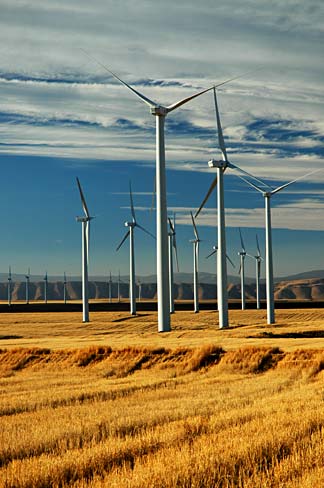 Oregonians rely on dependable, affordable energy to meet their basic needs. The state's energy comes from a variety of sources including hydropower, natural gas, and coal. Recent wind and solar power facilities make it more likely that energy comes from a renewable source.
Oregonians rely on dependable, affordable energy to meet their basic needs. The state's energy comes from a variety of sources including hydropower, natural gas, and coal. Recent wind and solar power facilities make it more likely that energy comes from a renewable source.
Finding suitable locations for energy development can be challenging. Environmental impacts need to be considered. Some energy projects need a lot of land, which impacts farming, forestry, and wildlife habitat. Cost is also an issue. The further an energy project is from transmission lines, the more expensive it is to build.
The Department of Land Conservation and Development has developed rules (OAR 660-033-0130(37) and (38)) for wind and solar energy siting on agricultural land based on input from energy providers and conservation groups. The rules are intended to direct energy development to lands that have limited value to wildlife and farming. For example, solar panels are allowed up to 12 acres in areas with the best soil for farming. Up to 320 acres of land may be used for solar in areas with poor soils and no water rights.
The construction and operation of energy-generating plants and transmission infrastructure affects wildlife habitat, farming, energy cost, and the natural landscape. Oregon Administrative Rules (OARs) provide guidance and directions on local land use decisions for solar and wind facilities, and policies for siting ocean energy facilities. However, the
Oregon Energy Facility Siting Council or the
Federal Energy Regulatory Commission makes the siting decisions for large energy facilities and transmission infrastructure. Uniform planning ensures that power plants and transmission infrastructure across the state are constructed and managed to minimize negative impacts while providing affordable energy to consumers.
In Oregon, ocean energy is considered a renewable energy source with the potential to reduce the human need of fossil fuels, such as coal or gas. Ocean energy facilities may promote the use of energy from wind, wave, current, or thermal, which may reduce the environmental impact of fossil fuels.
Oregon prefers to develop renewable energy through a protective approach that supports the use of pilot projects and phased development. Part Five of the Oregon Territorial Sea Plan describes the process for making decisions about the development of renewable energy facilities within Oregon's Territorial Sea. The Plan specifies the areas where new development may occur. The requirements of Part Five are intended to protect areas of important marine resources from the potential adverse effects of renewable energy facilities. The requirements address all phases of development including siting, development, operation, and removal from service. The Plan also identifies locations for development that may reduce damaging impacts to coastal communities and existing ocean resource users. If new facilities are developed in a responsible and appropriate manner, and in agreement with state and federal requirements, renewable ocean energy may help preserve Oregon's natural resources and enhance our quality of life.
Goal 13 addresses energy conservation efforts that should occur as part of city and county land use comprehensive planning. Planners are instructed to maximize the conservation of all forms of energy and to use sound economic principles when reviewing the energy-related projects. Goal 13 requires consideration of renewable energy sources but does not address where they should be located.
In 2019, the Oregon Department of Energy (ODOE) partnered with DLCD and the Oregon Institute for Natural Resources (INR) on a grant application to the U.S. Department of Defense for the study and assessment of renewable energy and transmission development in Oregon. Continued renewable energy development is anticipated in the coming decades, therefore we must work now to balance natural resource, land use, environmental impacts, noise concerns, and cultural issues through processes at all levels of government.
DLCD will be co-leading this project with ODOE to identify high potential renewable energy production areas that are feasible for development that overlap with military training and operations areas, and to review and assess the current development and siting procedures of local, state, and federal governments. Upon conclusion, a renewable energy siting mapping tool will be developed by INR with information gathered over the course of the project.
Learn more about this project on ODOE’s project web page.
Sign-up to receive email updates from ODOE.